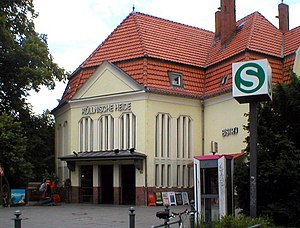Baumschulenweg–Neukölln connecting line
| Baumschulenweg–Neukölln link line | ||||||||||||||||||||||||||||||||||||||||||||||||||||||
|---|---|---|---|---|---|---|---|---|---|---|---|---|---|---|---|---|---|---|---|---|---|---|---|---|---|---|---|---|---|---|---|---|---|---|---|---|---|---|---|---|---|---|---|---|---|---|---|---|---|---|---|---|---|---|

Köllnische Heide station on the line
|
||||||||||||||||||||||||||||||||||||||||||||||||||||||
| Overview | ||||||||||||||||||||||||||||||||||||||||||||||||||||||
| Locale | Berlin | |||||||||||||||||||||||||||||||||||||||||||||||||||||
| Line number | 6021 | |||||||||||||||||||||||||||||||||||||||||||||||||||||
| Technical | ||||||||||||||||||||||||||||||||||||||||||||||||||||||
| Line length | 5.3 km (3.3 mi) | |||||||||||||||||||||||||||||||||||||||||||||||||||||
| Track gauge | 1,435 mm (4 ft 8 1⁄2 in) standard gauge | |||||||||||||||||||||||||||||||||||||||||||||||||||||
| Electrification | 750 V DC third rail | |||||||||||||||||||||||||||||||||||||||||||||||||||||
| Route number | 200.45, 200.46, 200.47 | |||||||||||||||||||||||||||||||||||||||||||||||||||||
|
||||||||||||||||||||||||||||||||||||||||||||||||||||||
Source: German railway atlas
The Baumschulenweg–Neukölln link line is a railway line in southern Berlin. It connects the Ring line (Ring Bahn) station of Neukölln via Köllnische Heide to Baumschulenweg on the Görlitz line. The line as originally designed only for freight but is now mainly used by Berlin S-Bahn trains.
The line was built at ground level a single track between 1890 and 1896 and was opened on 8 June 1896. At first, it only served freight, connecting the Görlitz line with the southern Ring line.
Beginning in 1910, two separate suburban tracks were laid north of the existing freight track. The entire line was rebuilt on an embankment with bridges over intersecting roads, including Kaiser-Friedrich-Strasse (now Sonnenallee) and Kiefholzstraße. At the same time the trackwork was rebuilt around Baumschulenweg station. As part of the redevelopment Köllnische Heide station was built where the line crossed Kaiser-Friedrich-Strasse. Preliminary work began in 1913 and the platforms were completed three years later. Further work, including the building of the reception building, was delayed due to World War I. The station was finally opened on 16 August 1920.
On 6 November 1928 the suburban lines were electrified.
Following the Nazi seizure of power in 1933, it created plans to turn Berlin into its World Capital Germania. This gave greater importance to the Ring Bahn, so that it would be used by all suburban trains and act like a big roundabout. The link to the Görlitz line was assigned an important role, but especially for long-distance, regional and freight traffic. The line would be expanded to a total of eight tracks, two of which would still be reserved for the S-Bahn. Four tracks would have been the mainline tracks of the rerouted Görlitz line. The remaining pair of tracks would form part of a new route connecting with the Lower Silesian-Markish line at Köpenick.
...
Wikipedia
